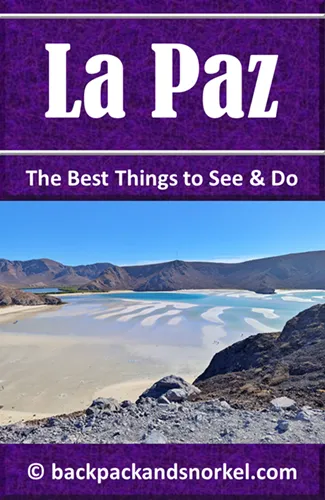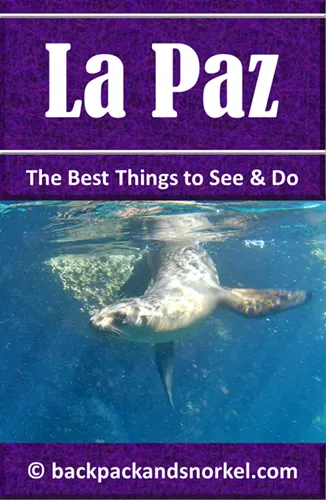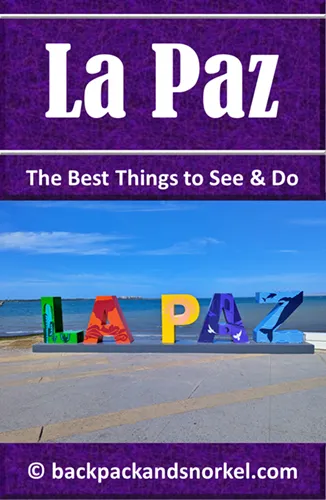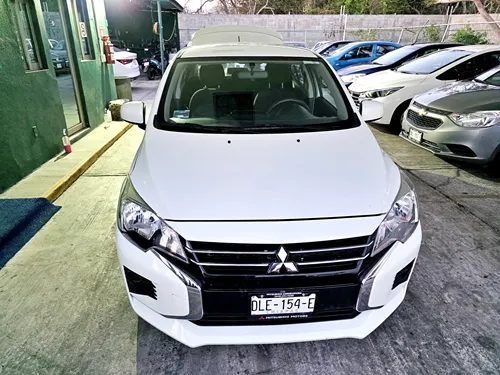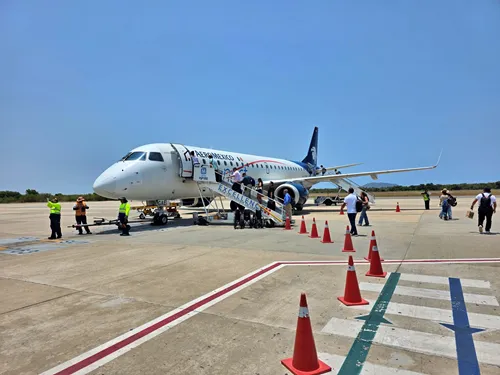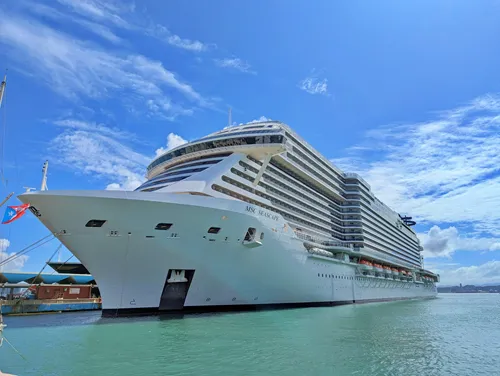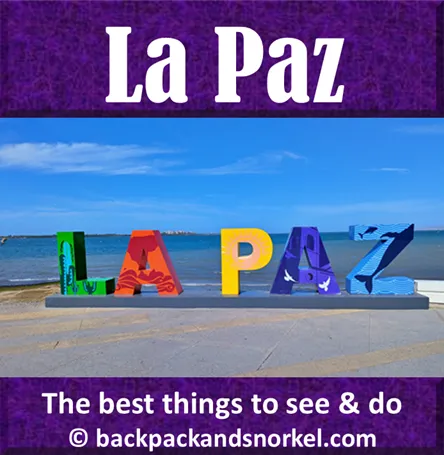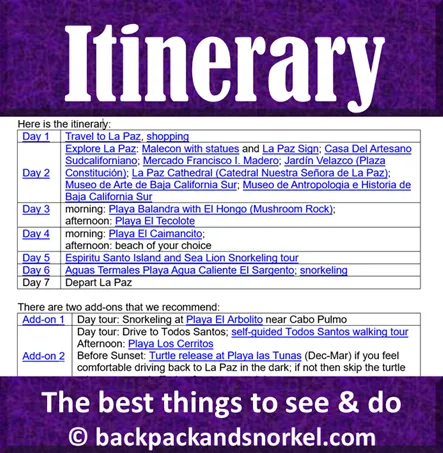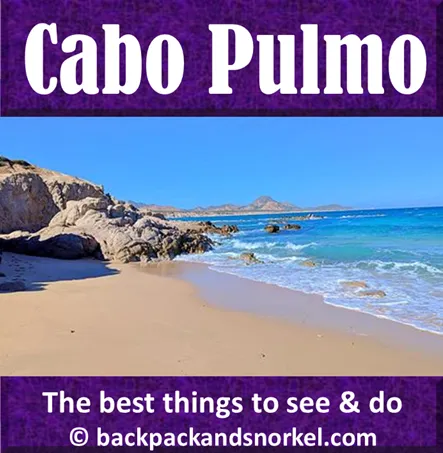Your Ultimate 7-Day La Paz, Mexico Itinerary: City, Malecón, Beaches & Snorkeling Adventure - La Paz Purple Travel Guide
Forget the rowdy spring break crowds of Los Cabos, and discover a side of Baja California Sur that's both captivating and serene. La Paz, the capital of Baja California Sur, offers a wonderful blend of vibrant authentic Mexican culture, and breathtaking natural beauty. Jacques Cousteau called the Sea of Cortez the ‘Aquarium of the World’, due to its large underwater biodiversity. You can experience this beauty in La Paz.
Unlike its more bustling neighbor La Paz, La Paz maintains its distinctly authentic Mexican charm. Stroll along the Malecon, the city's lively waterfront promenade, especially as the sun begins to dip below the horizon. Here, you'll find locals and visitors mingling, enjoying street art, vibrant sculptures, and the mesmerizing colors of a Baja sunset. The city's compact center makes it easy to explore on foot, discovering historical landmarks like the Cathedral Nuestra Señora de La Paz and charming plazas.
La Paz is home to some of Mexico's most postcard-perfect beaches. Playa Balandra is often hailed as the most beautiful, with its beautiful turquoise waters, striped beach near low tide, and the iconic ‘mushroom rock’ formation. This protected bay is ideal for swimming, kayaking, and simply soaking in the tranquil surroundings. Other stunning options include Playa El Tecolote, offering panoramic views of Isla Espíritu Santo, and the Aguas Termales (thermal hot spots) at Playa Agua Caliente in nearby El Sargento. Many beaches in the area boast clear waters teeming with colorful marine life, making them perfect for snorkeling or simply relaxing.
La Paz is not just about the ocean. Immerse yourself in the local culture by exploring museums, browsing artisanal markets and mercados, and discovering hidden street art. The food scene is a true delight, with an emphasis on incredibly fresh seafood. Beyond seafood, you will find traditional Mexican dishes with a unique Baja twist.
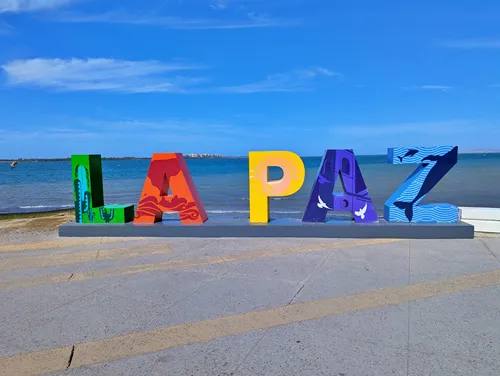
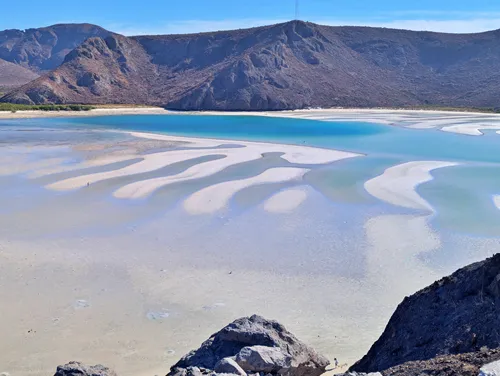

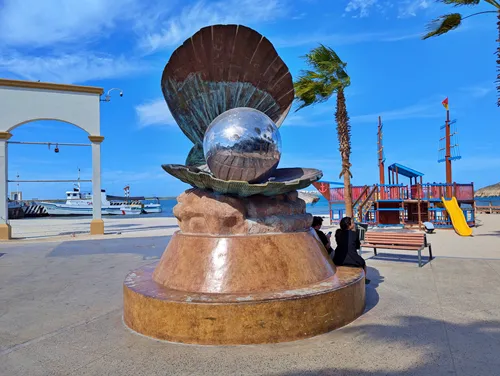
Here at Backpack and Snorkel Travel Guides, we typically promote self-guided walking tours.
But we realize that not everybody likes to walk by themselves in a foreign city. So, just in case that you rather go with ab guide: NO PROBLEM! Please see the Viator tours below.
paid Viator tours
General Information about La Paz
How much time do you need to visit La Paz?
La Paz offers a captivating blend of marine wonders, desert landscapes, and authentic Mexican charm.
Here is how many days you would need to experience La Paz
The basic ‘Taste of La Paz’ - 4 Days: This includes 1 day to explore the city, 1 day to enjoy Balandra Beach, and 1 day to visit Espiritu Santo Island or, depending on the season, a whale watching tour, or a swimming with whale sharks tour
The ‘Deep Dive’ - 5 to 6 Days: This is the sweet spot for most visitors. It includes the ‘Taste of La Paz’ itinerary, and adds a day trip to Aguas Termales Playa Agua Caliente El Sargento, and 1 more beach
The ‘Extended Stay’ - 7+ Days: This tour includes the ‘Deep Dive’ itinerary, and adds more beach relaxation on other beach(es), or additional day(s) on Balandra Beach
In this La Paz Purple Travel Guide, we present a seven-day itinerary for La Paz that introduces you to the best places to see in La Paz. You can use it as is, or you can tailor it to your interests by prioritizing your favorite destinations and by visiting your favorite beach or resort for many days in a row.
You can find the itinerary in the section 7-day Itinerary for Your La Paz, Mexico Trip.
What is the best time to visit La Paz?
La Paz is a year-round travel destination. The ‘best’ time to visit depends on your desired activities, tolerance for crowds, and heat.
Before we go to the details, here is a quick summary:
For Marine Wildlife Enthusiasts (Whale Sharks & Whales): December to March is your sweet spot. The underwater visibility is often still good enough in December, and some people can still swim or snorkel without wetsuits.
For Pleasant Weather & Fewer Crowds: May, October, and November are excellent choices. October and November typically have good underwater visibility and the water is warm enough for swimming and snorkeling.
For Diving/Snorkeling & Budget-Conscious Travelers: Embrace the summer months (June-September) if you can handle the heat. The best underwater visibility is typically from July to November.
Here is a breakdown to help you pinpoint your ideal travel time:
Peak Season: Winter (December to April)
This is La Paz’s busiest season. The weather is pleasantly mild and dry, with average temperatures ranging from 60°F (15°C) to 75°F (24°C). You will find abundant sunshine and clear blue skies, making it perfect for outdoor activities and beach relaxation. This time of year is still good for swimming and snorkeling, but since water temperatures are lower than in summer, more sensitive swimmers and snorkelers will need wetsuits from December on.
This is the prime time to swim with Whale Sharks (November to April, peak Jan-Feb) in the Bay of La Paz. While the official season runs from October to April, the highest concentration of whale sharks is typically from December to February.
If you don’t want to swim with whale sharks, you can do Whale Watching (December to April, peak Feb-March): Majestic gray whales, humpback whales, and even blue whales migrate to the warm waters of Baja California Sur during these months. You can embark on whale watching tours, with February and March often being the best for spotting multiple species.
December brings Christmas holiday cheer, and you will find a lively buzz throughout the city, and Christmas parades on the street by Malecon.
As this is the peak season, expect higher tourist numbers, more crowded tours and popular spots, and pricier accommodation and tour prices. It is often a good idea to book your accommodation and tours well in advance.Shoulder Seasons: Spring (May) & Fall (October-November)
These months offer a good balance of pleasant weather and fewer crowds, making them excellent choices for many travelers.
Spring (May): Temperatures start to rise but remain comfortable, typically ranging from 65°F (18°C) to 85°F (29°C). The desert flora can still be in bloom, adding a splash of color to the landscape. It is a good time for water activities as the sea begins to warm.
Fall (October-November): The intense summer heat begins to subside, offering warm but more manageable temperatures (70°F/21°C to 90°F/32°C). The water is still warm, making it ideal for swimming, snorkeling, and diving. Whale shark season also kicks off in October, although sightings will be less consistent than in the peak months.
Fewer Crowds & Better Value: You will generally find more availability for tours and accommodations, and often better prices than during the peak winter months.Low Season: Summer (June to September)
Summer in La Paz brings heat and humidity, but it also offers unique advantages for certain travelers.
The water temperatures are at their warmest, creating excellent conditions for swimming and exploring the underwater world by snorkeling or diving. Visibility can be superb.
As this is the low season for tourism, you can often find better deals on flights, accommodation, and tours.
If you prefer a more relaxed and less crowded experience, summer can be ideal.
Unique to the La Paz area, the cooling ‘Coromuel‘ night winds provide a welcome reprieve from the daytime heat. But daytime temperatures can soar, often reaching 95°F (35°C) or higher. The humidity is also elevated.
August and September are the wettest months, following the pattern of the North American Monsoon. While showers are often brief, they can be intense.
The Eastern Pacific hurricane season runs from May to November, with the highest risk of storms occurring between August and October. While direct hurricane hits are rare, it is something to be aware of.
Below is the climate that you can expect on your trip to La Paz:
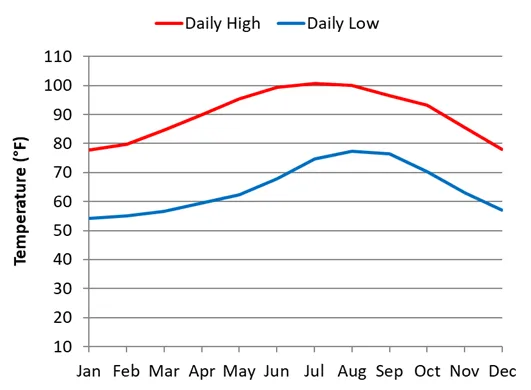
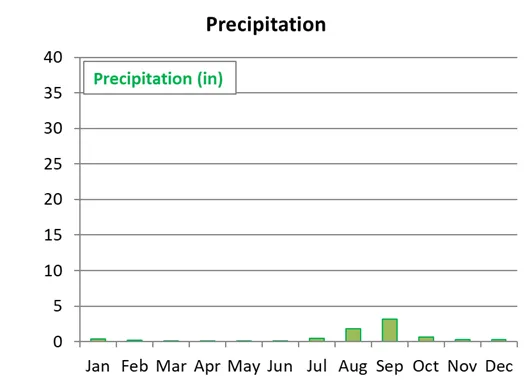
Here is the average sea temperature in la Paz:
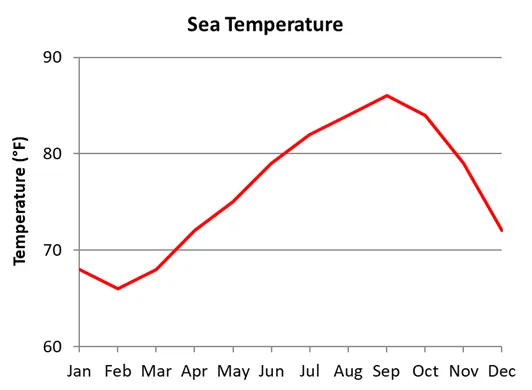
Highlights of the history of La Paz
10,000 BCE: Indigenous groups, including the Pericúes and Guaycuras, inhabit the Baja California peninsula.
1533: An expedition sent by Hernán Cortés first sights the bay.
1535: Hernán Cortés himself lands on May 3, naming the area Santa Cruz, and the bay: Bahia de la Santa Cruz (Bay of Santa Cruz). Cortés hears of reports of rich pearls and establishes a colony.
1536: The colony is abandoned due to harsh conditions, too few supplies, and conflicts.
Shortly after 1536: One of Cortés's subordinates or an enemy writer (maybe Alarcón) first applies the name ‘California’ to the abandoned ‘Santa Cruz’ territory. This is likely done to mock Cortés and the barren and challenging nature of the land, that was supposed to have mythical riches. The name California originates from a popular Spanish chivalric romance novel published in 1510. In this novel, California is a mythical island that is located near the terrestrial paradise and is populated by beautiful, black warrior women, and rich in gold and pearls.
1596: Explorer Sebastián Vizcaíno successfully establishes a more lasting presence, renaming the bay ‘La Paz’ (Peace).
1829: La Paz is designated the capital of the Las Californias region which includes Baja California and Alta California (today’s California, Nevada, and Utah, and parts of Arizona, Wyoming, and Colorado) after the capital city Loreto gets devastated by a hurricane.
1830: La Paz is named capital of Baja California, and Monterey becomes capital of Alta California.
1973: The Transpeninsular Highway significantly improves access to the peninsula.
1974: The international airport further connects La Paz globally, after a significant reconstruction that includes the construction of a new terminal and enlargement and modernization of the airport facilities.
1974: Baja California Sur officially becomes a state, with La Paz as its capital.
How to get to La Paz
From Los Cabos
Most of the international visitors arrive by plane at the Los Cabos International Airport (airport code SJD), which is located about 120 miles (191 km) or roughly a 2 ½ hour drive south of La Paz. Guests then either take a rental car and drive, or use a transfer service to get to La Paz.
Flying to the La Paz airport
Most Mexicans fly to La Paz International Airport (airport code LAP).
La Paz airport has direct flights from several major Mexican cities, including Mexico City (MEX), Guadalajara (GDL), and Tijuana (TIJ), but only few international connections. Flights from the USA to La Paz were historically mostly seasonal connections, and all were discontinued until recently. At the time of writing, only Alaska Airlines offer a direct flight from Los Angeles (LAX) to La Paz (LAP).
Arriving by Cruise Ship
Some guests arrive by cruise ship in La Paz. La Paz is a port of call for many Mexican Riviera cruise itineraries, particularly those sailing out of California ports like Los Angeles or San Diego. Cruise ships typically stop here for 1 or 2 days.
Cruise ships do not dock directly in downtown La Paz, but at Puerto Pichilingue (Pichilingue Cruise Port), which is about 12 miles (20 km) north of the city center.
Due to this distance, cruise lines typically provide complimentary shuttle buses from the Pichilingue port to the Tourist Bus Terminal in downtown La Paz, which is conveniently located across from the Malecon (waterfront promenade).
Some visitors come by ferry across the Sea of Cortez
For those coming from mainland Mexico or wanting a unique maritime experience, taking a ferry across the Sea of Cortez is a viable option.
Ferries are operated by Baja Ferries and connect La Paz (specifically the Pichilingue port, just north of the city) with two ports on mainland Mexico:
Topolobampo (near Los Mochis, Sinaloa): This is the shorter and often more frequent route, taking approximately 7-9 hours.
Mazatlán (Sinaloa): This is a longer journey, typically a 14-16 hour overnight crossing.
These are large car and passenger ferries, allowing you to bring your own vehicle – if you have a rental car, make sure that your rental car company allows you to take the car on the ferry. The ferries offer basic amenities, and some even have optional cabins for overnight journeys.
Drive to La Paz
Other visitors drive from various parts of Mexico to La Paz, and some people even make the long drive from the US to La Paz either in their own car or in a rental car.
La Paz and the entire Baja California Sur (BCS) peninsula are part of the so-called Mexico free/border zone. That means that drivers that enter BCS directly from the US only need the so-called Mexico insurance, but no TIP (Temporary Vehicle Import Permit). TIP is a mandatory permit that allows non-Mexican citizens to take a vehicle across the border into Mexico from other countries.
Should the vehicle leave the Mexico free/border zone at any time, then TIP is mandatory.
Please be advised that not having valid Mexico Insurance and/or TIP when needed will get you in deep trouble with Mexican law and you may even be detained.
If you drive your own car, check with your car's insurance company for Mexico Insurance policies.
If you get a rental car, then make sure that your rental car company allows their cars to be taken into Mexico. Historically, Dollar, Hertz, Alamo, and Enterprise have allowed to take their cars into Mexico, and it is possibly that other rental car agencies allow that too. But you absolutely need to verify that this is true for your rental.
In all cases, you will have to buy the Mexico Insurance from the rental company. The cost for a mid-size car used to be approx. $25-$40 per day when we did that a few years ago, but is likely more expensive nowadays.
How to get around in La Paz
Unless you plan to stay in the downtown area, or stay in walking distance to one of the beaches in La Paz, or you are fine with going anywhere by taxi, you will need a rental car to get around in La Paz.
La Paz and Balandra Beach are about 17 miles (27 km) apart and Playa Agua Caliente is 35 miles (57 km) from la Paz. You may also want to go shopping, and while there are many smaller grocery stores, Chedraui (map) is quite a walk from the Malecon.
This is Premium Content! To access it, please download our
Backpack and Snorkel Purple Travel Guide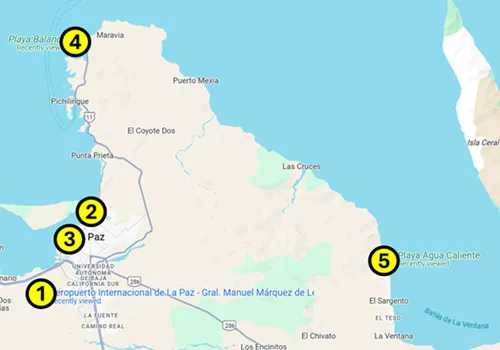
1 = La Paz Airport
2 = Malecon
3 = Chedraui
4 = Balandra Beach
5 = Playa Agua Caliente
Many of the big international car rental companies and some local Mexican companies are at the La Paz International Airport (LAP).
Gas stations are plentiful, and you can pay by credit card. Just be advised that you are not allowed to pump your own gas – an attendant will do that.
Tell the attendant ‘Lleno de premium por favor’ (please fill up the tank with premium gasoline) and, if they wash your windshield or perform any other service, tip them 10 or 20 Pesos. The double ‘L’ in ‘Lleno’ is pronounced like a ‘J’ in English and the ‘e’ in ‘Lleno’ and ‘premium’ are pronounced like the second ‘e’ in ‘behemoth’.
Parking in La Paz is usually not too difficult to find, especially if you are willing to walk one or two blocks, then you can usually find a spot.
Where do you want to go now?
Author: Rudy at Backpack and Snorkel
Bio: Owner of Backpack and Snorkel Travel Guides. We create in-depth guides to help you plan unforgettable vacations around the world.
Other popular Purple Travel Guides you may be interested in:
Like this Backpack and Snorkel Purple Travel Guide? Pin these for later:
